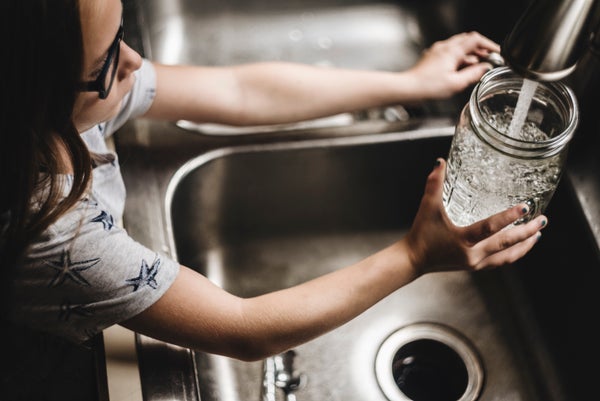How Will EPA’s New Rule about ‘Forever Chemicals’ Protect Your Drinking Water?
A new EPA rule will limit PFASs, or “forever chemicals,” in your drinking water for the first time. Here’s what that means for you
By Katherine Bourzac

Cavan Images/Getty Images
The U.S. Environmental Protection Agency has announced limits on “forever chemicals” in drinking water for the first time. The rule, detailed on April 10, applies to six persistent, toxic chemicals in a class called perfluoroalkyl and polyfluoroalkyl substances (PFASs). These substances are often colloquially referred to as forever chemicals because they do not readily break down in nature. But what does the agency’s announcement mean for the H2O that you consume daily?
That depends on how swiftly drinking water suppliers respond: they now have three years to test for these PFASs and two years to remove the chemicals from our taps.
PFASs have been widely used since the 1940s. They’re extremely durable, and they can repel both water and oil. They’re used in firefighting foams, nonstick cookware, stain-repelling clothing and food packaging, among other products. PFASs can enter the drinking water supply after they are discharged into rivers and lakes from manufacturing and processing facilities or industrial use. They can also enter the water system when firefighting foams seep into the ground. For people living near industrial sources of PFASs, drinking water is the main exposure route of these compounds.
On supporting science journalism
If you’re enjoying this article, consider supporting our award-winning journalism by subscribing. By purchasing a subscription you are helping to ensure the future of impactful stories about the discoveries and ideas shaping our world today.
These chemicals were initially designed in an era when “we thought persistence was a great property,” says Cheryl Murphy, director of the Center for PFAS Research at Michigan State University. PFASs are strings of carbon atoms bound to fluorine atoms, resulting in one of the strongest chemical bonds found in nature. But the durability of the chemicals also means they accumulate in our body and in the environment. PFAS molecules have water-repelling and water-attracting parts—just like the lipid molecules that make up our cell membranes. “They transport really easily, hitching a ride on water molecules,” Murphy says. “They bind to our cell membranes and to proteins.”
According to a 2023 U.S. Geological Survey study, 45 percent of tap water across the country contains PFASs. The substances have also been found in people’s blood and widely in the environment.
Some water agencies already treat tap water for PFAS using technologies that include filters based on granulated activated charcoal and reverse osmosis. These methods clean up the water to make it safer to drink, but they leave behind PFASs as a waste product. Due to their persistence, these PFAS can’t be readily broken down. Murphy says scientists are still investigating technologies that can work at the scale needed to break down PFASs filtered from the nation’s water.
For individuals concerned that there may be PFASs in their tap water before the EPA begins enforcing its new rule, the nonprofit Environmental Working Group recommends certain PFAS filters. Because PFASs don’t break down inside these filters, it’s important to follow the package directions and replace the filters when recommended. Bottled water is not necessarily free from harmful chemicals. A 2021 study tested 101 U.S. bottled water products and found that 39 contained PFASs.
The new EPA regulation covers six of the more than 10,000 different kinds of PFASs. Five are regulated individually or as parts of mixtures, and the sixth is regulated when found in combination with one of the others above certain concentration limits. Those six PFASs are among the best studied and have been linked to adverse health effects, including cancer and immune system disorders. “Long-term exposure to certain types of PFAS has been linked to serious illnesses, including cancer, liver damage and high cholesterol,” said EPA administrator Michael Regan during a call with reporters on April 9. The agency estimates that these rules will protect 100 million people from exposure to PFASs at unsafe levels. “This action will prevent thousands of deaths and reduce tens of thousands of serious illnesses,” Regan said.
The EPA has estimated that 6 to 10 percent of the country’s 66,000 water systems will have levels exceeding the drinking water maximums for at least one of the six newly regulated PFASs. But we won’t know the extent of the problem until officials complete testing within three years.
Murphy says that having the federal government mandate testing across the entire country addresses current inequities: today some states and water agencies test for PFASs, and some don’t. “It’s an environmental justice issue,” she says. Regulating these compounds at the federal level means every drinking water supplier will have to test for these six kinds of PFASs—and everyone in the U.S. will have access to more information about the safety of their water, Murphy adds. The EPA maintains a searchable database of violations of drinking water standards where this information will be available.
>>> Read full article>>>
Copyright for syndicated content belongs to the linked Source : Scientific American – https://www.scientificamerican.com/article/how-will-epas-new-rule-about-forever-chemicals-protect-your-drinking-water/































